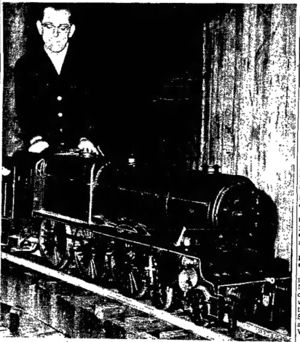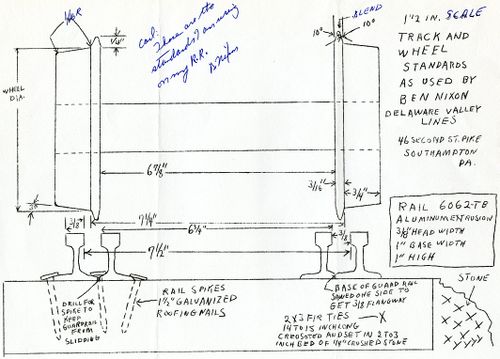Ben Nixon
Backyard Locomotive Brings Kids
Railroad Buff Is Fired Up
by Leonard MacBain, Staff writer
The Daily Intelligencer, Doylestown, PA
22 September 1962
"When I start kindling the fire and raise the steam in the engine, all the youngsters in the neighborhood arrive. They smell the steam, I guess," said Ben Nixon as he stood beside his old steam engine which runs over 300 feet of track on the grounds of his Southampton, PA home.
Ben Nixon, 50, started railroading, "when I was a kid and never grew up." He added, "the steam engine is my first love."
Nixon's steam engine is a mode of the Royal Scot, a crack British train that runs between London and Edinburgh, Scotland.
The engine was owned originally by Norvin Rinek, owner of the Rinek Rope Works, in Easton.
According to Nixon, Rinek had the engine built in England at a cost of $4,100 for his children and his own amusement.
Rinek owned the engine from 1937 to 1959, a period of 22 years. He sold the engine then to Nixon at a much less figure than its original cost. "It is still perfect," said Nixon.
Ben, a handy do-it-yourself man has built nine cars for the engine to pull around the 300 feet of track.
The equipment, standing on rails in the engine house at track side, includes a caboose, gondola, hopper car, and five flat cars.
A little riding car with seats was included in the purchase price of the engine.
"It takes 35 to 40 minutes to kindle the fire and raise steam in the engine," Ben noted.
"During that time I clean and oil the engine. When the steam is raised the engine can be operated continuously and indefinitely."
Ben sits atop the tender to operate the engine while it spins over the rails.
In the cab of the "iron horse" can be found the throttle, steam brakes, reverse gear, injectors for putting water into the boiler, blower vales, oiler valves, steam gauge, water gauge and brake controls for the tender. The chime whistle on the engine is also controlled from the cab.
Ben explained there is no headlight on the engine, "which is typical of the European trains which operate without a headlight on fenced-in right of ways."
"The engines there carry marker lights, red and green, for identification and signalling," he explained.
"In Britain the steam locomotive is still used to great extent. There are no steam engines in regular service on first class railroads in America today."
Nixon expects to eventually increase his 300 feet of track to 1,000 feet. At present he is building a bridge across the creek that flows through his property for an extension of the new track.
After the train then crosses the bridge, it will go over a grade crossing, and proceed through a deep cut of five to six feet which will be built up on both sides with rough stone. The new track for the train will then be built down steam for several hundred feet, and will recross the stream via another bridge to be built and continue back to the starting place.
The train runs on a seven and one quarter inch gauge track.
Alongside of the present right of way Nixon has built a six by 16 foot engine house, with a spur line of track running into the building to house the engine and cars. The interior of the engine house and a portion of the right of way is flood-lighted for night operation.
Nixon said "I built the engine house from a crate that Tinius Olsen Testing Machine Co. of Easton Rd., Will Grove had received a new lathe in from western Germany."
Nixon is employed in the day-time as an instrument maker at the Tinius Olsen plant where he has worked for the past three years.
The live steam buff said he plans a spur from his right of way into a new workshop he is building in the basement of his home at 927 Woodland Dr., Casey Park, Southampton, PA, so the locomotive can be run into the workshop for servicing and repairs.
He also anticipates building a rotary snow plow to be pushed by the engine during the snowy winter months.
What kind of coal do you use in the engine?
"Sometimes I use Welsh coal imported from Wales which is an ashless coal, but due to the expense of it I more frequently use West Virginia soft coal. I buy four or five hundred pounds of coal at a time."
Nixon uses a miniature shovel to put coal into the engine. He pointed out that he consumes five or six pounds of caol to raise the steam.
Ben collects books, whistles, parts, articles and just about everything pertaining to railroads.
He explained that he is an ex-president and director of the National Railway Historical Society. He attends various meets where there are live steam activities and operation; he goes to Southwick, Mass. twice a year to a meet conducted by the Pioneer Valley Live Steamers.
There are several prominent live steam clubs on the California coast, he noted.
He explained that adults and children can ride on his steam train. he has carried as many as 20 children or a dozen adults at one time.
"My wife Ruth loves railroading too. She can drive the engine. So can my two sons, Fred, 26 and James, 24. Our little girl, Betty, six, can run any Diesel engine, but not the steam engine as yet."
Before going to work for Tinius Olsen, Nixon owned a model train business which was located on the Second Street Pike in Southampton, PA. It was called the Delaware Valley Hobby Shop. He still owns the building, but has leased the shop.
In 1930 he began making model trains and sold them to friends. After the second World War he started manufacturing trains under the name of Nixon Model Co. in Southampton.
In 1949 he erected the building in Southampton, where he opened the hobby shop, and manufactured the trains in the basement.
"I start the outdoor railroad at the Hobby Shop to promote business. I had a fenced-in line in front of the building, between the shop and street. That was Diesel train and motorists by the dozens would stop to watch it operate.
"At Christmas time I used to put a Santa Claus on the train, with the six and seven car train carrying gaily wrapped Christmas packages, plus tricycles and toy autos for children."
Nixon sold his Southampton business in 1959 and in 1960 bought his property in Casey Park. He brought his railroad track and trains with him.

